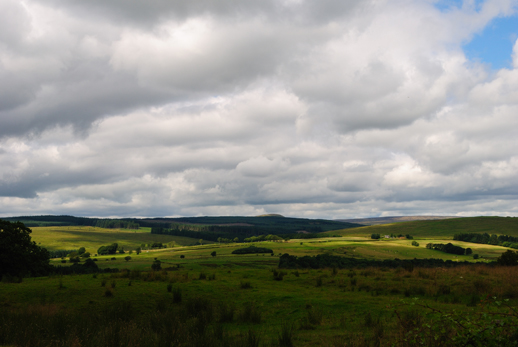by Lisa Samson
We spy our first red squirrel huddled up an alder tree when we are looking for the dismantled railway path from Penton to Kershopefoot. The shy squirrel, so different from its grey brothers, is a welcome diversion from the overgrown scrub we’re trying to walk through. We give up on the railway path when we reach a ‘Private’ sign, turning instead along a shady lane of birch and ash trees. Ash trees have mythical powers of healing and protection and they certainly provide cool relief from the relentless sun. Spruce trees are etched around the field boundaries, thousands of spindly crosses reaching skyward, forming a darker layer in the pastel shades of green that rise towards the heather on the moors.
A hedgehog walking in the middle of the road soon scurries for cover when my son starts clicking his camera. We did it a favour by scaring it because a few minutes later a white van swerves past us, the driver ‘s mouth agape. Clearly, he doesn’t see many walkers and his is the first vehicle we’ve seen since the tractor that passed us two hours ago.
We walk past a white-washed cottage where an old man sunbathing on his garden bench is startled to see us. He seems delighted to chat so I don’t feel guilty for disturbing him. His resemblance to Moonface from the Faraway Tree stories is so striking that when he says we are a long way from Kershopefoot, it crosses my mind that he may have a secret slide we can pay him toffee to use. I am quite confused about which county we’re staying in because we booked to stay in Northumberland but the woman in the antique shop in Newcastleton insists that Saughs farm is in Cumbria. It seems that every hour we cross a border line that welcomes us to Scotland or England, as if we are indeed spinning around and around, visiting different lands. On the map, the border line jerks back and forth like a jagged cut, as if hacked by the reivers all those centuries ago.
It is hard to reconcile these sleepy hills with their turbulent history. This area twelve miles long by four miles wide, where Dumfries meets Cumbria and Northumbria, was called the Debatable lands because for three centuries it was neither Scottish nor English, its ownership fiercely disputed and control falling into the hands of reivers, outlaw clans who pillaged and robbed people of their animals and crops. These lawless brigands held the populace in their sway and rampaged through the countryside for centuries, fighting bloody battles amongst themselves and against the English or Scots, depending on where their allegiance lay. Since the antique shop owner claims to be an Elliot, one of the fiercest reiver families, I decide to accept her assertion that our holiday farm is in Cumbria.
As we approach Kershopefoot, we surprise two roe deer, who dart fearfully towards the forest. The next part of our walk takes us away from the village, following the river up to Kershope Bridge with the forest on our right. The forest floor is covered in moss of emerald green, rich as the cloaks worn by the fairy kings and queens. The spruces grow so close together that only red squirrels and deer and other fairy-footed creatures can scamper there. I gaze wistfully at the dappled sunlight that endows the green carpet with an ethereal glow.
Many shades of purple flowers grow wild here: dainty Harebells nod over bristly Marsh Thistles and blue-violet clusters of Tufted Vetch climb amongst the grasses. The flora and fauna of the area more than compensate the walker for the lack of maintained footpaths. Giant Hogweed and long legged ferns, force-watered in the heavy rains, are reminiscent of the surrealist setting of a J.G. Ballard novel, in which freakish nature has caused the vegetation to grow to twice its usual height. At Kershope Bridge the scene that greets us seems typically Scottish; cattle drinking from the river by fir trees, before roaming freely over the moors. We are lucky enough to spot a young Hen Harrier sitting at the water’s edge before it spreads its wide wings and swoops down over the riverbank.
In the evening we sit under the mizzle, sipping wine as midges dance their courtship of us, their nibbles lighter than fairies as they mark our skin with tender bites we don’t discover until the itching hours of dawn. The sky is the palest of Turner water colours, and it would take more water than paint to mix the right hues of blue on the palette. We are waiting for the clouds to clear so that we can see the stars that are brighter here because there is so little artificial light. After three nights of waiting the clouds eventually disappear and the stars are indeed the most dazzling I have ever seen.
Lisa Samson is a writer of fiction and creative non-fiction. Her work has appeared in Brand Magazine and A Wilder Vein, an anthology focusing on the relationship between people and places in the natural environments of Britain. Her first novel Talk to me was runner-up in the Virginia prize for Fiction 2011.
